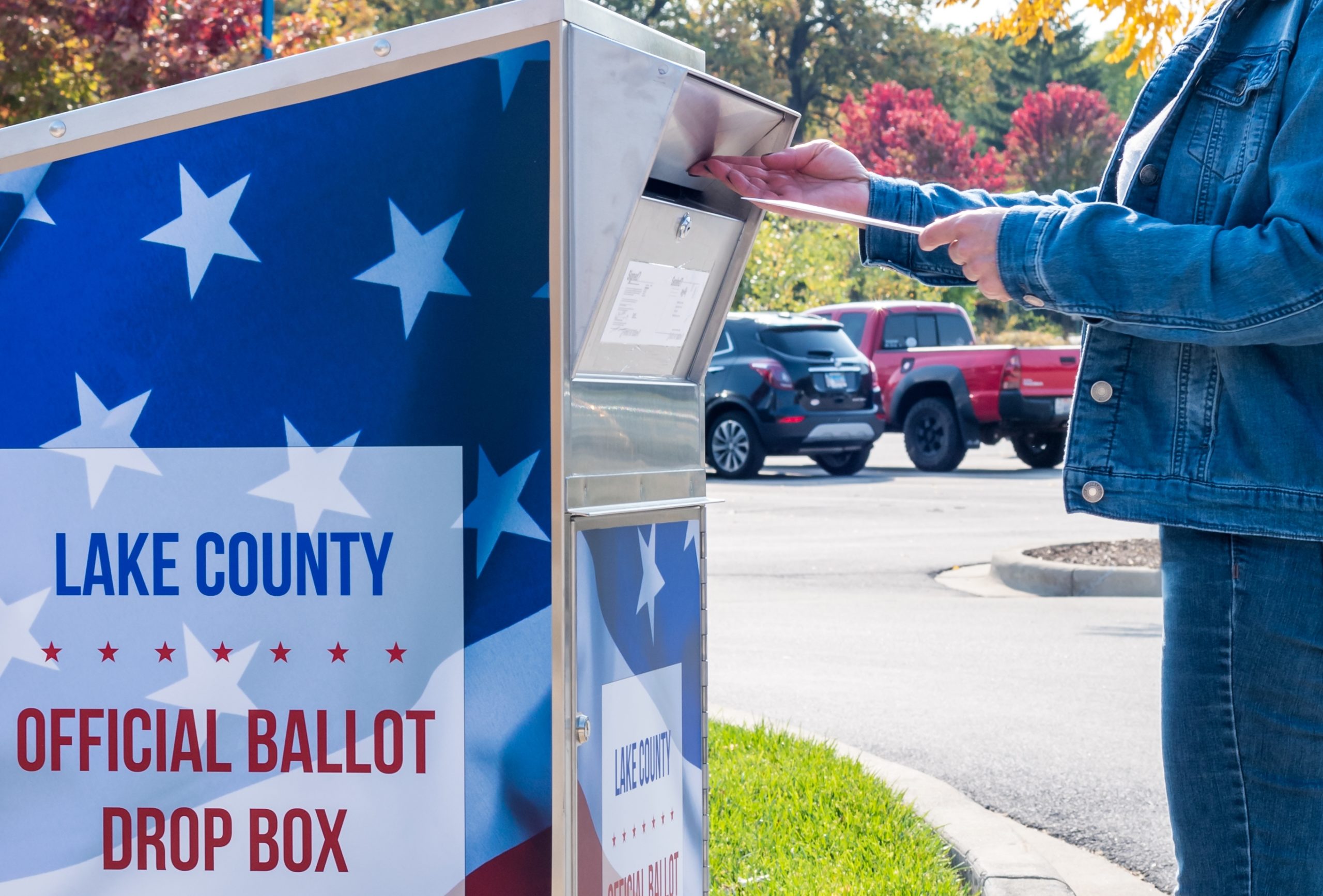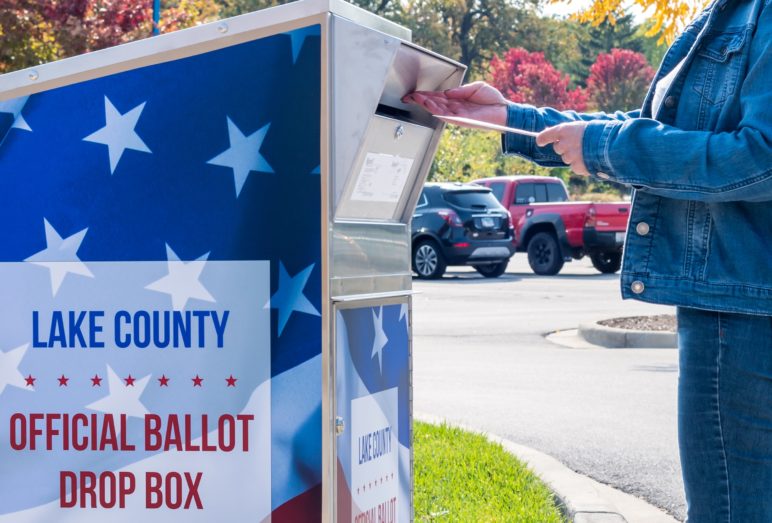Montana conducted its first statewide all-by-mail election in June, and saw the best voter turnout in a primary in nearly 50 years. Given the public health risks involved with in-person voting this year, Governor Steve Bullock, with the support of key Republican policymakers, including the House speaker and Senate president, passed an executive order that allowed Montana counties the option of conducting the primary all by mail.
Bullock didn’t mandate a vote-by-mail election. Rather, he allowed counties the local option of an all-by-mail election—all registered voters in those counties would receive ballots in the mail and could complete it at home and mail it back or drop it at an election office in-person. Voters would still have the option to register or vote in person on Election Day if they chose.
Montana already mails a ballot to any voter who requests one. In Montana’s 2018 general election, three voters mailed in absentee ballots for every one voter that chose to cast a ballot in person on Election Day. And for years many counties had already conducted all-mail-in local elections and were familiar with the process. All counties took the option to mail ballots to all voters in the primary. Bullock gave counties the same option in November, and only about 10 counties didn’t mail ballots out to all registered voters in the general election.
Audrey McCue, elections administrator for Lewis and Clark County in Helena, told the Missoula Current that absentee ballots have been widely and successfully used by the state’s voters for years, without evidence of fraud.
“Even when we have the polls open, people have been voting absentee,” McCue said. “So the system has been tested. It’s been tested for years, and we haven’t seen voter fraud happen through this system.”
Among registered voters, 54.9 percent cast ballots in June, Montana’s greatest turnout in a primary since 1972. Nancy Liefer, president of Montana’s League of Women Voters, expected record turnout. And indeed Montana hit 80 percent turnout in the general election.
Liefer said other factors also played a role in turnout this year. She believes the coronavirus, and how governments responded to it, showed the public the influence that state and local officials have on important policy decisions. Montana this year also has several competitive state races: the governorship, a Senate seat, and a House seat.
“People are much more aware of the importance of voting,” Liefer said. “Because it’s turned out to be governors who have made the difference. It’s becoming clearer and clearer that state legislatures, for example, can make really big decisions with what’s happening with Covid.”
Native voters face barriers due to distance and racism
Montana voters in 2018 approved an initiative, known as the Ballot Interference Prevention Act, that restricted organizers’ ability to collect ballots. Proponents claimed that the initiative would protect ballots from tampering. But in reality, voter fraud or ballot tampering is essentially nonexistent in Montana’s decades-long history of mail-in local elections. By preventing voting advocacy groups from collecting ballots, the initiative made it more difficult for Native Americans living far from a post office or election offices to vote—one of Sightline’s best practices recommendations is to allow community groups to deliver signed and sealed ballots.
Marci McLean, executive director of Western Native Voice and part of the Blackfeet Nation, said some voters have to travel as far as 70 miles to the nearest post office or election office. That’s why community groups often collect signed and sealed ballots from Native residents and drive them to an elections office in a single trip. In the 2018 midterm election, McLean said Western Native Voice picked up 853 ballots.
By blocking organizers’ collection efforts, the 2018 initiative could keep those 853 people from voting. Western Native Voice, Native American Rights Fund and ACLU sued Montana’s secretary of state, arguing that the law violated voting rights of Native Americans. They won. A Montana judge ruled that the law restricts Native voting rights and was unconstitutional. Yellowstone County District Judge Jessica Fehr issued a temporary restraining order on May 20, 13 days before the primary and not enough time for organizations to collect ballots.
The percentages of voter turnout among tribal nations were consistently higher in the 2020 primary than in the 2016 primary, according to data gathered by Western Native Voice. And with organizations again allowed to collect and deliver ballots, there was more opportunity for Native voters to participate in the general election. We don’t yet know how many ballots Western Native Voice picked up and delivered for the 2020 general.
But Native Americans, especially living on reservations, are especially prone to disenfranchisement and had lower turnout than the overall Montana voter population. For example, in Blaine County, home to most of the Fort Belknap Indian Reservation, primary turnout was just 46 percent, compared with 72 to 76 percent in some majority-white counties. Turnout increased to 75.9 percent in the general election, compared to the statewide 76.4 percent turnout.
“If we’re preventing one person from voting, that’s one person too many because of the barriers or obstacles they’re facing,” McLean said. And if Montana were to move to a permanent vote-by-mail system, the state would need to do a lot more to make voting accessible to tribal nations, McLean added—from expanded drop boxes, to allowing ballots to be forwarded, to voting centers on tribal land.
She’s concerned that mail-in ballots could disproportionately disenfranchise Native voters. The biggest challenges McLean sees in Montana are election offices’ inability to accommodate voters who live far from a post office and to get ballots to voters with nontraditional addresses.
Many Native communities across the country have had to fight to get polling places and voting offices located on tribal lands so that Native voters can enjoy the same access to voting locations that other voters have.

Many Native communities across the country have had to fight to get polling places and voting offices located on tribal lands so that Native voters can enjoy the same access to voting locations that other voters have. All-mail elections will mean they’ll have to go through the same fight to get drop boxes located on tribal lands. During this election, the Republican National Committee filed suits in Pennsylvania and Texas aimed at limiting drop boxes. If that trend continues, Native advocates could have their work cut out advocating for more drop boxes.
Native voters often can’t get their ballots delivered to their homes because they don’t have an address the US Postal Service recognizes. They also can’t return ballots easily, often having to drive several miles to access a post office, election office, or drop box. Many Natives don’t have access to some form of transportation. Some may not speak English, aren’t provided translation services, and can’t read their own ballots. McLean said in states like Washington and Oregon, where mail-in elections have been conducted for years or decades, Native communities still aren’t granted the same equal access to resources. Washington has conducted all mail-in elections since 2011 but just last year passed its Native American Voting Rights Act, which allows Natives to register to receive ballots with non-traditional addresses, allows voter registration with tribal ID online, and improves access to ballot boxes on reservations. Reservations aren’t guaranteed drop boxes. Of the 29 recognized tribes in Washington, 10 have a drop box on reservation land, and 11 have one within five miles of the boundaries of the reservation, Crosscut reported.
McLean said a history of discrimination and racist policies left many Natives with a lack of trust in the mail system as well as election offices where a voter would typically ask for help if they encounter problems casting their ballot. Even when Native Americans do access election offices, stories of them experiencing discrimination or racism when they ask for help are common, McLean said. For example, she heard from a Native man that a local clerk refused to issue him a replacement ballot. Liefer said the League of Women Voters chose not to advocate for mail-in elections because of the concerns around how mail-in elections would impact Indigenous communities.
Kiersten Iwai, executive director of Forward Montana, a nonprofit which galvanizes young people to vote, said young voters are disproportionately impacted because they often move.

“There’s a lot of work that needs to go into a policy that creates a vote-by-mail system” that would equitably take tribal communities into account, McLean said.
Young voters face barriers due to moving
Kiersten Iwai, executive director of Forward Montana, a nonprofit which galvanizes young people to vote, said young voters are disproportionately impacted because they often move. Nearly 34,000 mailed-out ballots were undelivered in the primary. Among voters between the ages of 18 and 24, 13 percent of ballots were undelivered. Among those between the ages of 25 and 34, 17 percent of ballots were undelivered. That percentage drops to just 7 percent of voters aged 35-44. Ballots can’t be forwarded to new addresses in Montana.
This year, Forward Montana also had to figure out how to turn out their votes with limited ability to hold events or meet people face to face.
A permanent vote-by-mail system would be a major political challenge for Montana. Look no further than what happened in 2017, when a Republican state legislator tried to pass a bill to send all registered voters absentee ballots for a special election.
Montana legislators in the state House blocked a mail-in election in 2017
When Zinke resigned from Congress to become US Interior Secretary, that left the state with an unexpected May special election—and three months to tell the public about it. That prompted serious discussions about pursuing a mail-in election. Should the state simply mail ballots out to all registered voters?
Informing voters about the special election presented a challenge, and voter turnout was historically higher with mail-in elections. Voting by mail would’ve also offered a solution to some of Montana’s other problems: It would’ve saved an estimated $500,000 to $750,000 of public funds, said state Senator Steve Fitzpatrick, a Great Falls Republican who sponsored the bill. Some counties were short-staffed for polling places. And they had just gone over-budget in the last election that required reprinting ballots at a time local governments were struggling. State senators approved the bill in a 37-13 vote and transmitted it to the House only a week after the bill was introduced.
But by the time the discussions got to the House, “the politics kicked in,” Liefer said.
Then-Montana GOP chairman Jeff Essmann claimed that allowing mail-in elections would give Democrats an advantage because of their ability to organize. He sent an email to Republican policymakers, claiming that allowing mail-in elections would favor Democrats and potentially mean long-term damage to Montana’s Republican party.
“This bill could be the death of our effort to make Montana a reliably Republican state,” Essmann wrote. State representatives killed the bill, despite both Republican and Democratic county commissioners urging them to save their local taxpayers’ money.
Fitzpatrick in a House committee pleaded that the bill be taken seriously and brought evidence to show that voting by mail favors no party. Susan Good Geise, a Lewis and Clark County commissioner and former state legislator, in her testimony said she’s been a Republican “for as long as I’ve had a pulse.” She spoke of a strong grassroots push by the Montana Republican Party in 1992, when she chaired the party, to bring back its majority in the legislature. And they did.
“Those majorities were earned. We got there by hard work and not voter suppression,” Geise told the committee. “Who do you serve, party leadership or your taxpayers? Please choose wisely.”
State representatives stalled Fitzpatrick’s bill. Montana that year held a special election with a 54.7 percent turnout.
Sightline Institute is a 501(c)3 non-profit organization and does not support, endorse, or oppose any candidate or political party.
Hayat Norimine, research contributor, is a freelance writer who grew up in Washington on the border of Idaho. She previously covered city halls and politics for The Dallas Morning News, Seattle Met magazine, and The Daily News in Longview, Washington. She has an MA in journalism from the Medill School of Journalism and a BA in English from the University of Washington. For Sightline, she researches and writes about democracy reform and elections issues and reports on fossil fuel proposals along the Thin Green Line.
For press inquiries and interview requests, please contact Anna Fahey.
Get your copy of Sightline’s new book, Becoming a Democracy: How We Can Fix the Electoral College, Gerrymandering, and Our Elections.











